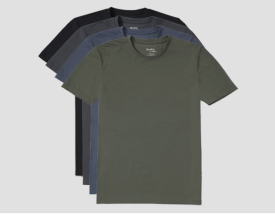Body odor is a natural phenomenon that every human being experiences. Yet it remains a significant concern for many. While often associated with sweat, the true culprit behind unpleasant smells isn't perspiration itself, but rather the interaction of sweat with bacteria residing on the surface of our skin. This fundamental understanding is crucial to appreciating how anti-odor fabrics work to keep us fresh and confident.
Anti-Odor vs. Sweat-Wicking: There’s A Difference
Before diving deep into the world of anti-odor technology, it's essential to clarify a common misconception: anti-odor fabrics are not the same as sweat-wicking fabrics. While both are often found in athletic wear and performance garments, their primary functions differ significantly.
Sweat-wicking fabrics are designed to move sweat away from the surface of your skin, allowing it to evaporate quickly. This process helps regulate body temperature and provides a cooling effect, which is why they are commonly used in athletic or workout clothes. Fabrics like polyester, which repel water, are often found in moisture-wicking garments because they don't absorb as much water as cotton. However, sweat-wicking fabrics do not inherently control body odor.
Anti-odor fabrics, on the other hand, are specifically concerned with the bacteria that react with sweat to cause odor. Their core mechanism involves capturing, blocking, or even killing these odor-causing bacteria on the skin's surface. By eliminating the bacteria, they prevent the reaction that leads to unpleasant smells, thereby eliminating odor.
So, while sweat-wicking helps you stay dry and cool, anti-odor technology directly addresses the root cause of body odor: bacterial growth.
How Certain Fabrics Worsen Body Odor
You might have wondered if the clothes you wear contribute to body odor. The answer is a resounding yes. The type of fabric can significantly affect your body odor, with man-made or artificial fabrics being notorious for increasing body odor.
Common artificial fabrics include:
- Nylon
- Polyester and polyester fleece
- Spandex
- Acrylic
- Olefin
- Microfiber
- Neoprene
- Vinylon
- Synthetic fur, suede, and leather
These fabrics, which include branded synthetics like Gore-Tex, Lycra, Polartec, Dri-FIT, and CoolMax, can actually worsen body odor due to their unique properties and chemical composition.
Here’s why artificial fabrics are problematic:
The main issues stem from how these fabrics handle heat, moisture, and bacteria.
Heat and Moisture Trapping: The molecules in artificial fabrics are tightly packed, making them excellent insulators. This design traps body heat and moisture, creating a perfect environment for bacteria to flourish. Unlike natural fibers, synthetics are poor at absorbing moisture directly from your skin because their fibers are so tightly woven.
Odor Development: When the chemicals in these man-made fibers mix with your skin's natural oils and sweat, they can produce an unpleasant smell. While artificial fabrics are hydrophobic (water-repelling) and are used for "moisture-wicking" by pushing sweat away, they are also oleophilic (oil-loving). This means they leave behind the oily substances in your sweat, which then become a prime breeding ground for bacteria. This combination of factors often intensifies body odor, making it "nearly impossible to prevent odor from flourishing on these fabrics or remove it with washing."
Bacterial Growth and Skin Issues: Synthetic fibers like polyester, nylon, and spandex are notorious for trapping moisture and limiting airflow. Sweat particles get caught in the fabric's "nooks and crannies," giving bacteria plenty of food and space to multiply, leading to body odor. Because these fabrics are often nonporous and impermeable, the strong odors can be incredibly difficult to wash out. This lack of breathability can also worsen certain skin conditions by blocking moisture and creating an ideal environment for microbes.
Beyond fabric choice, other factors can influence body odor, including your lifestyle, diet, medications, heavy exercise, and underlying health conditions like diabetes, gout, or kidney disease. Hormonal changes can also contribute.
How Anti-Odor Technology Works
Anti-odor technology fundamentally prevents stink by stopping microorganisms from growing. It works by capturing, blocking, or killing the bacteria on your skin that combine with sweat to cause odors. These fabrics absorb gasses, incorporate antimicrobials, and actively deodorize, keeping you fresh and even reducing the chance of outdoor cross-infection. This innovative approach is rapidly gaining traction especially in sportswear, with companies developing high-performance, sustainable anti-odor garments.
How Different Technologies Fight Odor
Various methods infuse textiles with anti-odor properties, each with its own mechanism and considerations:
Chemical Treatments: Common methods involve chemicals like hydrogen peroxide (e.g., Thompson Tee's Odor Shield™) or triclosan. These chemicals weaken or kill microbes, but their effectiveness can diminish with washes. Concerns exist regarding their safety (e.g., endocrine disruption by triclosan) and potential environmental contamination as they wash out.
Silver Technology: Silver, a natural antimicrobial, releases ions that are lethal to odor-causing bacteria when it oxidizes. Incorporated into textiles through knitting or weaving, it's widely used in athletic wear. However, its efficacy also decreases with washing, and prolonged exposure can potentially cause skin staining or adverse reactions.
Zeolites: Derived from volcanic ashes, zeolites absorb and break down odor molecules, releasing them during washing. This can mean less frequent laundering. However, it's considered a relatively unproven technology with limited scientific testing to confirm long-term safety and efficacy.
The Natural Solution: Odor-Resistant Fibers
For those seeking odor resistance without advanced treatments, natural fibers offer inherent benefits:
Cotton: Known for moisture absorption, cotton soaks up sweat and allows skin to breathe, preventing odor-causing bacteria and sweat from trapping smells.
Bamboo: An excellent moisture-wicker (40% more than cotton), bamboo keeps you dry and contains natural bacteriostatic and antifungal agents for inherent odor resistance without chemicals. It's also soft and hypoallergenic.
Linen: This highly breathable fiber promotes air circulation, is naturally microbial, and helps keep skin dry by reducing perspiration. Durable and thermo-regulating, it's ideal for hot, humid conditions.
Wool: Wool's outer layer traps moisture, inhibiting microbe growth. It's highly hygroscopic, absorbing significant water without feeling damp, which prevents sweat and unpleasant smells. Merino wool is particularly effective.
Hemp: Like other natural fibers, hemp allows the body to breathe and doesn't trap moisture.
Natural fibers soothe, ventilate, and help regulate body temperature, offering a sustainable and environmentally friendly alternative that has been used for centuries to stay cool and fresh.
Practical Tips for Preventing Body Odor

While choosing the right fabrics is a major step toward preventing body odor, it's part of a holistic approach that includes personal hygiene and lifestyle choices.
Here are some pointers to help you avoid body odor:
Maintain Cleanliness: Keep your body thoroughly clean to prevent bacterial growth.
Regular Clothing Changes: Wash your clothes and change them frequently, especially if you are sweating heavily. However, it is generally advised to avoid frequent washing of anti-odor garments to enhance their longevity. This creates a balance, where natural fibers might require more frequent washing if you sweat heavily, while anti-odor treated garments might benefit from less frequent washing. Get bad smells out of your clothes for good.
Use Antiperspirants: Apply antiperspirants to areas prone to heavy sweating. Applying it after a shower can help wash away accumulated sweat from the body.
Dietary Adjustments: Consider cutting out foods that can influence body temperature or odor, such as hot peppers, excessive onions, and garlic.
Keep Skin Dry: The main strategy to curb skin odor is to keep your skin dry, as bacteria tend to replicate rapidly in damp and moist environments.
Bottom line
What you wear really affects how you smell. Artificial fabrics can trap sweat and bacteria, leading to body odor. Luckily, anti-odor tech helps by killing or blocking these odor-causing germs. Some of these methods, like hydrogen peroxide, are safe and effective. Even better, natural fabrics like cotton, bamboo, linen, and wool naturally fight odor by letting your skin breathe and managing moisture. They're also good for the planet.
Ready To Fight Body Odor? Get Started With Neat Apparels.








